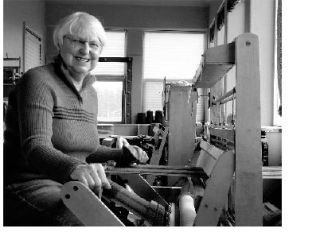For Lopez Island weaver Linda Graham-Rose, a strong sense of place is linked inextricably to her art. From the signs which line her driveway, informing visitors that this is the Chris Jensen Homestead, 1887 (a great, great uncle) and the birthplace of Hazel Nielsen, 1919, “Linda’s mom,” to Graham-Rose’s hand-woven blankets and tea towels, it is all about the feeling of home.
“My first loom, a floor loom, was built by Ken’s aunt and uncle in 1954.” Ken is Ken Rose, Graham-Rose’s husband of 49 years, and the color of the welcoming signs on the way to their house—John Deere green and yellow—is a testimony to one of his interests.
After receiving this loom from Ken in 1968, Graham-Rose says that, “like most passions in our lives, I fell into weaving. Because I was working six days a week and only able to weave in my spare time, I say that during my first 20 years of weaving, I had one year’s experience 20 times.”
Like many local artists, moving to Lopez provided the necessary catalyst for Graham-Rose to begin developing beyond that “one year’s experience.” After settling here in 1994, she discovered the support and guidance of the weaving group on Lopez, particularly Suzanne Nicholson, whom Graham-Rose credits as “a terrific leader.”
From the beginning, Graham-Rose was attracted to the elements of weaving: fiber, color, and texture. She was captivated by the fact that she could “scramble all that up and see how it’s going to come out. Anything that’s hand woven is special.”
She also discovered that such hand woven items made wonderful gifts, of which her children were the first recipients; Graham-Rose didn’t begin selling her art until she found she couldn’t give her children any more.
(Here, Graham-Rose begins talking about her three grown children, where they live and what they do, and once more the powerful sense of home, of place, begins to blossom in the room where we sit.)
Graham-Rose explains her various looms by saying that she likes to “jump looms,” keeping several projects going at once on different looms. She gestures toward her “conversation loom,” sitting on a table top beside a chair in her living room and so-named because she can come out from her workroom and talk to Ken, while continuing to weave.
This strategy of jumping looms is part of how Graham-Rose “keeps it fun.” She creates a variety of hand-woven pieces, among them tea towels, scarves, jackets, and rugs she fashions from Pendleton wool. She points to one such rug, hanging on the wall, and says that she “painted the inside of the house to match it (the rug’s) colors.”
Felted kiddie balls are made from the remnants of the rugs. She also makes hats and blankets. Displaying a blanket she has just completed, she explains the process she uses when someone commissions such a piece from her: “I find out what colors the person wants, as well as the size they want. Then I figure out the total square feet and how much time and material that requires so I can give you a price. I always tell people if they don’t like the finished product, that’s no problem, because I can always find someone who does.”
Graham-Rose, whose weaving is being featured in Chimera Gallery (chimeragallery.com) through May 7, takes pleasure in knowing her work is an integral part of people’s homes.
When asked what advice she would give novice weavers, she urges them to “come and get inspired” by the Lopez Weavers group which meets the second Wednesday of every month. (Interested people may call Graham-Rose at 468-4830 to find out details. Use this number for commission enquiries as well.) One of her looms, a Willis Loom built in Bellingham in 1974, is being featured in the Woodmen Hall auction on the Sunday of Memorial Day weekend and Graham-Rose says this particular loom is ideal for beginners.
Weaving is believed to have existed as part of the earliest civilized societies and is as much a part of human history as any other constituent. It seems appropriate that the road to Lopez weaver Linda Graham-Rose is clearly a road back to who she is, where she came from—a road back home.



